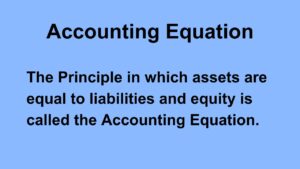To understand the accounting equation, we need to know how an accounting system captures relevant data about transactions, and then classifies, records, and reports data.
What is an Accounting Equation?
The Principle in which assets are equal to liabilities and equity is called the Accounting Equation. The company’s accounting system reflects two basic aspects: what it owns and what it owes. Assets are resources that the company owns or controls and have future benefits. Examples are cash. supplies, equipment, and land. The claims on a company’s assets–what it owes- are separated into owner and non-owner claims. Liabilities are what a company owes its owners (creditors) in future payments, products, or services. Equity (also called owner’s equity or capital) refers to the claims of its owner(s). Together, liabilities and equity are the source of funds to acquire assets. The relation of assets, liabilities, and equity is reflected in the following accounting equation:

The formula of the Accounting Equation:
Assets = Liabilities + Equity
In this equation, liabilities are usually shown before equity because the company must pay creditors’ claims before satisfying the claims of owners. The accounting equation applies to all transactions and events, to all companies and forms of organization, and to all points in time.
Example:
Assets = 100000, Liabilities = 20000, Equity = 80000
Answer:
100000 = 20000 + 80000
100000 = 100000
Assets
The company owns or controls assets, and these assets are expected to yield future benefits. Examples are Web servers for an online services company, musical instruments for a rock band, and land for a vegetable grower.
A company that provides a service or product on credit has accounts receivable from that customer, representing an asset that promises a future inflow of resources.
Liabilities
Liabilities are creditors’ claims on assets. These claims reflect obligations to provide assets, products or services to others. The term payable refers to a liability that promises a future outflow of resources. Examples are wages payable to workers, accounts payable to suppliers, notes payable to banks, and taxes payable to the government.
Equity
Equity is the owner’s claim on assets. It is equal to assets minus liabilities. This is the reason equity is also called net assets or residual equity. Equity for a non-corporate entity-commonly called owner’s equity increases and decreases as follows owner investments and revenues increase equity, whereas owner withdrawals and expenses decrease equity.
The owner contributes assets to the company, and they include them under the generic account “Owner, Capital.” Revenues boost equity and represent the assets earned from the company’s earnings activities, such as providing consulting services, selling products, renting out facilities to others, and earning commissions from services.
Owner withdrawals are assets an owner takes from the company for personal use. Expenses decrease equity and are Examples are costs of employee time, use of supplies, advertising, utilities, and insurance services from others. In sum, equity is the accumulated revenues and owner investments less the accumulated expenses and withdrawals since the company began. This breakdown of equity yields the following expanded accounting
Net income occurs when revenues exceed expenses. Net income increases equity. A net loss occurs when expenses exceed revenues, which decreases equity
Frequently Asked Questions
What is the Accounting Equation?
The accounting equation, also known as the balance sheet equation, represents a fundamental principle in accounting. It states that the total assets of a business are equal to the total liabilities and owner’s equity.
What are Assets in the Accounting Equation?
A business owns or controls economic resources that have value and can be used to generate future benefits. They include cash, accounts receivable, inventory, property, and equipment.
What are Liabilities in the Accounting Equation?
Liabilities are obligations or debts that a business owes to external parties. Examples include accounts payable, loans, and accrued expenses.
What is the Owner’s Equity in the Accounting Equation?
Owner’s equity, also called shareholder’s equity or net assets, represents the owner’s residual interest in the business. It is the difference between a company’s assets and its liabilities.
Why is the Accounting Equation Important?
The accounting equation is vital because it forms the basis for all financial transactions and reports. It helps businesses track their financial health, make informed decisions, and prepare accurate financial statements like the balance sheet.
